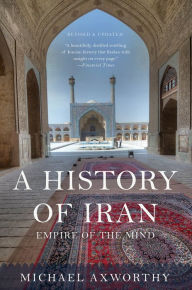The Ornament of the World: How Muslims, Jews, and Christians Created a Culture of Tolerance in Medieval Spain
Paperback
(Reprint)
$17.99
- ISBN-13: 9780316168717
- Publisher: Little, Brown & Company
- Publication date: 04/02/2003
- Edition description: Reprint
- Pages: 352
- Sales rank: 73,131
- Product dimensions: 5.50(w) x 8.25(h) x 0.88(d)
Eligible for FREE SHIPPING details
Choose Expedited Delivery at checkout for delivery by. Tuesday, October 15
17.99
In Stock
Widely hailed as a revelation of a "lost" golden age, this history brings to vivid life the rich and thriving culture of medieval Spain where, for more than seven centuries, Muslims, Jews, and Christians lived together in an atmosphere of tolerance, and literature, science, and the arts flourished. of photos. 3 maps.
Customers Who Bought This Item Also Bought
-
- The Basque History of the…
- by Mark Kurlansky
-
- Lisbon: War in the Shadows of…
- by Neill Lochery
-
- Civilization of the Middle…
- by Norman F. Cantor
-
- Venice: Pure City
- by Peter Ackroyd
-
- Peter the Great: His Life and…
- by Robert K. MassiePeter the Great
-
- The Medici: Power, Money, and…
- by Paul Strathern
-
- Venice: A New History
- by Thomas F. Madden
-
- Jerusalem 1913: The Origins of…
- by Amy Dockser Marcus
-
- In the Wake of the Plague: The…
- by Norman F. Cantor
-
- The Last Days of the Incas
- by Kim MacQuarrie
-
- A History of Iran: Empire of…
- by Michael Axworthy
-
- Columbus: The Four Voyages,…
- by Laurence Bergreen
-
- The Shadow of the Sun
- by Ryszard KapuscinskiKlara Glowczewska
-
- The Artist, the Philosopher,…
- by Paul Strathern
-
- Sprezzatura: 50 Ways That…
- by Peter D'EpiroMary Desmond Pinkowish
Recently Viewed
Miami Herald
...tells the story exceptionally well...a skillful history of...political history...
Wall Street Journal
...a lively read and gives us a fascination insight into the history of almost 800 years...
Booklist
...displays a lavish sense of place that should be the envy of many novelists...seductively written...
Washington Post Book World
...an affectin g portrait...a splendid account...the beauty lies in [Menocal's]...eye for the illuminating anectote...
Library Journal
Menocal (R. Selden Rose Professor of Spanish and Portuguese and director of Special Programs in the Humanities, Yale Univ.) has previously published The Arabic Role in Medieval Literary History: A Forgotten Heritage, as well as other books on the role of the vernacular in medieval cultures. This book certainly reflects her deep scholarship. Menocal offers persuasive evidence that the Renaissance was strongly foreshadowed by the intellectual climate of Spain in the preceding centuries, starting in 783 with the founding of Andalusia by Abd al-Rahman, an Umayyad from Syria. The culture created was receptive to intellectual pursuits not allowed in the rest of Europe for several centuries, including the creation of impressive libraries and the study and translation of Classical authors. Menocal claims that this environment was largely a result of the tolerance shown by this ruler and his successors toward Christians and Jews and their cultures. Menocal has not given us a history book so much as a demonstration that puritanical cultures of any ilk are detrimental to the development of science, art, and literature. Her arguments are convincing even without the dark background of September 11. Recommended for all libraries.-Clay Williams, Hunter Coll. Lib., New York Copyright 2002 Cahners Business Information.
Kirkus Reviews
A resonant and timely case study of a time when followers of the three monotheisms set aside their differences and tried to get along. Golden ages always turn out to have their rotten linings, but the centuries when a tolerant Muslim dynasty ruled over most of Spain were uncommonly free of nastiness. So writes historian Menocal (Humanities/Yale Univ.) in this unusually graceful study, a sturdy and eminently readable exploration of the "unknown depths of cultural tolerance and symbiosis in our heritage" that may help revise our view of the Middle Ages. Ruling from 756 until 1492, the Ummayads and their political descendants took a broad view of life, according equal status to their fellow "peoples of the Book," the Christians and the Jews of Spain. In time, these peoples blended and became nearly indistinguishable, a troubling matter to those powerful Christian regimes elsewhere in Europe who branded their Spanish brethren as Mozarabs, or, in Menocal's translation, "wanna-be Arabs." This equality, or dhimma, led to great things, including the flourishing of scholarship and the arts, to say nothing of "virtually unlimited opportunities in a booming commercial environment" brought on by the absence of ethnic strife. The era's monuments, the great towers and mosques of southern Spain, still endure, as does its great literary testament, Don Quixote, "a postscript to the history of a first-rate place." Alas, writes Menocal, this wonderland came crashing down with the late medieval clash of Inquisitorial Christian armies and fundamentalist Muslims, when purity of blood and of faith became the ideals of a Spain determined to root out its Islamic heritage, intolerant ideals that were soon to betransported to the New World. Contemporary Israeli poets and Arab intellectuals pine for the glories of al-Andalus, as did Federico Garcia Lorca and Antonio Machado. So, too, does Menocal.
















